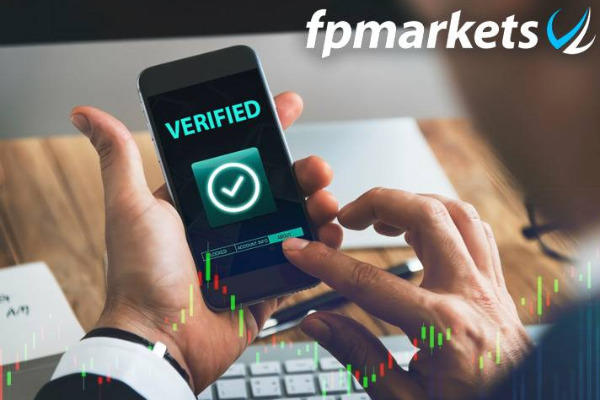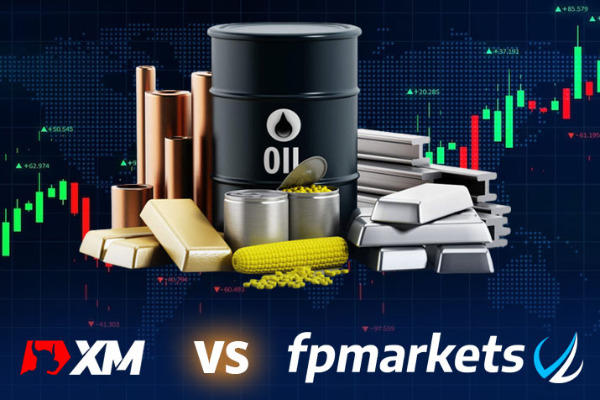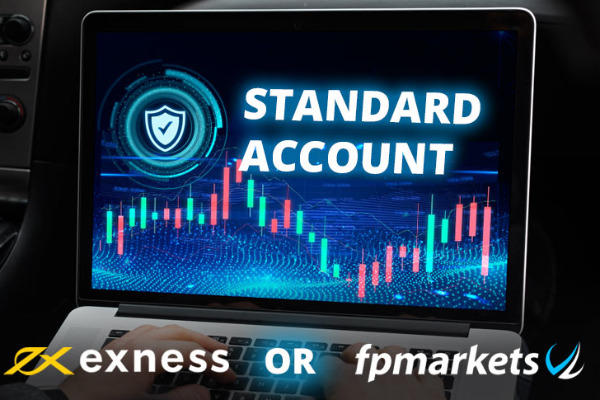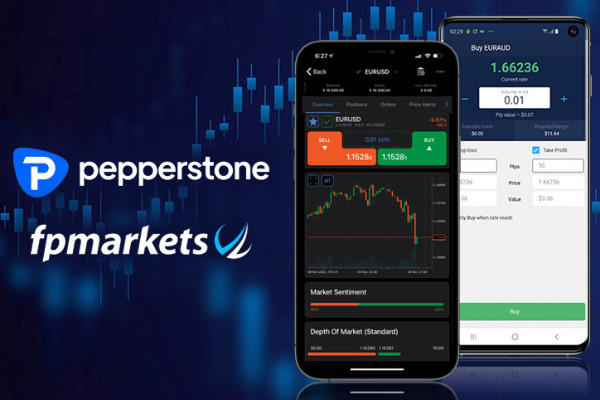In terms of cryptocurrency trading, is FP Markets better than Pepperstone? To help you decide, let's discuss both brokers here.
The rise of cryptocurrencies in the financial world has captured the interest of millions of traders who are looking to capitalize on their inherent volatility and potentially high returns. However, as the number of people venturing into the cryptocurrency market continues to grow, it has become increasingly important to find a broker that is reliable and trustworthy to trade with.
Choosing the right broker can have a significant impact on your trading experience, from the number of trading pairs available to the security of your funds, and every other factor that can make or break your success in the market.
In light of this, we will be comparing two of the most popular brokers in the industry - FP Markets and Pepperstone - specifically for cryptocurrency trading.

While both brokers offer a wide range of financial instruments, we will be focusing our attention on their cryptocurrency offerings, such as the variety of coins available for trading, the trading platforms offered, the fees charged, and the regulatory framework under which they operate.
Broker | FP Markets | Pepperstone |
💼Regulated by | ASIC (286354), CySEC (371/18), FSA | ASIC (414530), BaFIN (151148), CMA (128), CySEC (388/20), DFSA (F004356), SIA (F217) |
💻Trading Platforms | Metatrader 4 & 5 | Metatrader 4 & 5 |
Instruments | 12 pairs (BTCUSD, ETHUSD, XRPLUSD, LTCUSD, BCHUSD, ADAUSD, DOGUSD, EOSUSD, LNKUSD, SOLUSD, and XLMUSD) | 21 pairs (Crypto10 Index, Crypto20 Index, Crypto30 Index, BTCUSD, ETH/USD, LTC/USD, BCHUSD, ADAUSD, LINKUSD, DASHUSD, DOGEUSD, EOSUSD, DOTUSD, XRPUSD, XLMUSD, UNIUSD, BNBUSD, XTZUSD, SOLUSD, AVAXUSD, and MATICUSD) |
⚖Leverage | 1:5 | 1:5 |
💸Commission | $3/lot | $3.5/lot |
🎓Educational content | Webinars, tutorials, market analysis | Webinars, tutorials, market analysis |
These factors will help traders make an informed decision and ensure that they are well-equipped to make the most of their trading opportunities while mitigating any risks involved. Now let's explore each feature on FP Markets and Pepperstone individually:
Cryptocurrency Trading in FP Markets
Since 2005, FP Markets has been offering clients the opportunity to trade on the forex market. With over 10,000 trading instruments available, traders have plenty of options to choose from. The broker is known for its favorable trading conditions, quick order execution, popular trading terminals, and low spreads.
FP Markets is closely monitored by reputable regulators, including the Australian Securities and Investments Commission (ASIC) with license number 286354, and the Cyprus Securities and Exchange Commission (CySEC) with license number 371/18. The company is also registered and has an office in Saint Vincent and the Grenadines (SVG FSA).
When it comes to trading cryptocurrencies, FP Markets traders can engage in the buying and selling of 12 digital pairs such as BTC/USD (Bitcoin), ETH/USD (Ethereum), XRP/USD (Ripple), LTC/USD (Litecoin), BCH/USD (BitcoinCash), ADA/USD (Cardano), DOG/USD (Dogecoin), EOS/USD (EOS), LNK/USD (Chainlink), SOL/USD (Solana), and XLM/USD (Stellar). Keep in mind that the cryptocurrency market differs from traditional financial markets in that it operates 24/7 and is known for its high volatility, where prices can rapidly fluctuate.
FP Markets provides traders with access to a wide range of cryptocurrency trading pairs via its popular MetaTrader 4 and MetaTrader 5 platforms. These platforms offer advanced charting tools and technical indicators, which allow traders to perform a thorough analysis of the market and make informed trading decisions.
Furthermore, FP Markets offers competitive spreads and leverage of up to 1:5 for cryptocurrency trading, allowing traders to maximize their potential profits.
Choosing a cryptocurrency broker also depends on the fees charged. FP Markets offers competitive fees, with spreads starting from as low as 0 pips on some cryptocurrency pairs. Additionally, they charge low commissions on trades, with fees starting from just $3 per lot.
Finally, FP Markets provides an extensive range of educational resources to help traders improve their understanding of cryptocurrency trading. These resources include webinars, tutorials, and market analysis, enabling traders to stay up to date with the latest market trends and make informed trading decisions. By providing a variety of resources, FP Markets supports traders in their efforts to develop their trading skills and succeed in the world of cryptocurrency trading.
See Also:
Cryptocurrency Trading in Pepperstone
Pepperstone is a broker that has been in operation since 2010. This broker has more than 4 million clients who utilize its forex/CFD trading services. Pepperstone is regulated by ASIC 414530, BaFin 151148, Capital Markets Authority of Kenya 128, CySEC 388/20, DFSA (Dubai) F004356, FCA 684312, and SCB SIA-F217.
Pepperstone has seven well-regulated subsidiaries that limit the possibility of fraudulent activities and malpractice. Clients of Pepperstone can enjoy certain features such as negative balance protection and segregated deposits from corporate funds. Depending on the subsidiaries, traders can engage in leveraged trading with different maximum leverage:
- The Kenyan subsidiary offers negative balance protection with a maximum leverage of 1:400.
- Traders at the Bahamas subsidiary can use maximum leverage of 1:200 without negative balance protection.
- Pepperstone Australia offers a maximum leverage of 1:30, negative balance protection, but no compensation scheme for depositors.
- Pepperstone UK offers maximum leverage of 1:30, negative balance protection, and the best regulatory-mandated compensation scheme of £85,000 per client.
Pepperstone was founded in 2010 by a team of experienced traders with a shared commitment to improve the world of online trading. Based in Melbourne, Australia, they grew to become one of the largest forex brokers in the world. If traders want to find a broker that provides low spreads, fast execution, and award-winning support, then the answer is Pepperstone.
Pepperstone has a strong legality guarantee because it has been licensed by the Australian regulator ASIC and FCA. Traders' funds can be deposited in segregated accounts at top Australian banks, one of which is the National Australia Bank (NAB). Therefore, the safety of funds is not a concern if a trader chooses to open an account in Pepperstone.
They succeeded in collaborating with 23 top banks to bring Bid to investors instantly via optical fiber. This allows all orders to be executed 100 percent automatically with low latency up to 0.05 milliseconds, without dealing desk intervention and requotes, as well as with super low trading costs.
Trusted by over 73,000 traders around the world, Pepperstone processes an average of USD12.55 billion of trading volumes every day. Because of that, they have many awards such as:
- The Best Global Forex ECN Broker 2019 and Best Forex Trading Support-Europe
- Best Australian Broker and Best Trading Platform 2018 by Compareforexbrokers.com
- Best Forex ECN Broker, Best Forex Trading Support, and Best Forex Trading Conditions by UK Forex Awards 2018
With the many rewards gained, Pepperstone hopes to attract more and more traders from all over the world. The rising performance of Pepperstone is not only due to the super-tight spreads and fast execution that it provides, but also because many traders are interested in trading with deposits in currencies other than US Dollars.
For this reason, Pepperstone is one of the most market-responsive brokers because it is willing to accept deposits in 10 currencies, which include AUD, USD, EUR, CAD, GBP, CHF, JPY, NZD, SGD, and HKD.
Trading in Pepperstone would allow traders to choose between 11 trading platforms: MT4 for desktop, MT4 Mac, MT4 iPhone, MT4 Android, MT4 iPad/Tablet, MT5, WebTrader, cTrader WebTrader, cTrader cAlgo, and cTrader Mobile. The choice of trading platforms may seem confusing to novice traders, but actually, it is very useful because it has fast execution.
When trading forex, traders can enjoy raw spreads from 0.0 pips on Razor accounts, over 61 currency pairs, and commission-free account funding on a wide range of deposit options. In addition to currency pairs, Pepperstone provides many types of trading instruments, including CFDs for indices and shares, commodities, and cryptocurrencies.
Instruments in commodity trading are pretty much diversified. Not only metal, gold, and silver, but traders can also trade with soft commodities such as cotton, sugar, coffee, cocoa, and orange juice. Pepperstone also provides trading on energy (oil and gas).
There are two types of accounts provided by Pepperstone, namely Razor accounts, and Standard accounts. If you area beginner, it is recommended to choose a Standard account with an average EUR/USD spread of 1.0-1.3 pips and free commission.
Those with particular trading styles such as scalpers and algorithmic traders may enjoy the lower cost setup traditionally seen in a Razor account, with a commission from AUD7 round turn of 100k traded. You can start trading with a minimum lot of 0.01 (micro) and 1:400 leverage.
As a Pepperstone client, a trader can fund and withdraw with alternative methods including Visa, Mastercard, POLi internet banking, bank transfer, BPay, PayPal, Neteller, Skrill, and Union Pay.
If you are new to trading or looking to practice your trading strategies in a risk-free environment, you can create Demo Account in Pepperstone. But if you are an experienced trader or prefer to learn by doing, Pepperstone provides a Live Account that allows you to trade with live executions and pricing.
Traders can also follow and copy strategies from popular traders using third-party services while learning how to improve their trading abilities. Pepperstone has partnered with a range of social trading platforms that traders can choose from, such as Myfxbook, ZuluTrade, Mirror Trader, MetaTrader signals, and Duplitrade.
With Pepperstone, traders have access to 21 cryptocurrency trading pairs, which include three crypto indices of Crypto10 Index, Crypto20 Index, and Crypto30 Index as well as 18 cryptocurrency trading pairs such as BTC/USD (Bitcoin), ETH/USD (Ethereum), LTC/USD (Litecoin), BCH/USD (Bitcoin Cash), ADA/USD (Cardano), LIN/KUSD (Chainlink), DASH/USD (Dash), DOGE/USD (Dogecoin), EOS/USD (EOS), DOT/USD (Polkadot), XRP/USD (Ripple), XLM/USD (Stellar Lumens), UNI/USD (Uniswap), BNB/USD (Binance Coin), XTZ/USD (Tezos), SOLUSD (Solana), AVA/XUSD (Avalanche), and MATIC/USD (Polygon).
With a leverage of up to 1:5, Pepperstone provides access to cryptocurrency trading through its MetaTrader 4, MetaTrader 5, and cTrader platforms. Both offer advanced charting tools and technical indicators to help traders analyze the market and make informed trading decisions.
Crypto trading in Pepperstone is supported by a range of educational resources to help traders improve their understanding. The program includes webinars, tutorials, and market analysis to help traders stay up to date with the latest market trends and make informed trading decisions.
In terms of fees, Pepperstone offers very competitive fees, with spreads starting from as low as 0 pips on some cryptocurrency pairs. They also charge low commissions on trades, with fees starting from just $3.50 per lot. This means that clients can keep their trading costs to a minimum, which is essential for maximizing their profits.
Where to Find the Information on the Official Broker Site?
- This information is reported per Apr 24 2024.
- We can not ensure if this offering is still available or remain the same in future.
- The broker announcement page may or may not exist anymore, You may explore Pepperstone homepage and try to find "Promotion" section on the menu, footer, etc, to ensure the availability and validity of this promotion.
So, FP Markets or Pepperstone?
While both FP Markets and Pepperstone have their respective strengths in cryptocurrency trading, the choice ultimately depends on the trader's individual needs and preferences.
FP Markets offers lower commission fees, with rates starting from $3 per lot, which is cheaper than Pepperstone's $3.50 per lot. This can be an attractive feature for traders who prioritize keeping their trading costs low.
On the other hand, Pepperstone offers a wider variety of cryptocurrency trading pairs with 21 instruments available compared to FP Markets' 12. This variety can provide traders with more opportunities to trade and diversify their portfolios.
Another factor to consider is the trading platform. Both brokers offer MetaTrader 4 and 5, which are popular and widely used platforms for trading. However, Pepperstone also offers cTrader, which is known for its advanced charting tools and user-friendly interface.
In summary, traders looking for lower commission fees may prefer FP Markets, while those who prioritize a wider range of trading pairs and a more advanced trading platform may opt for Pepperstone. Ultimately, it is important to carefully evaluate your trading goals and needs, as well as the features and services offered by each broker before making a decision.
Final Thought
To summarize, FP Markets and Pepperstone are both well-established brokers that provide various cryptocurrency trading options to traders. Both offer access to popular cryptocurrencies such as Bitcoin, Ethereum, and Litecoin, as well as other altcoins with competitive spreads and leverage options. Additionally, both brokers provide educational resources such as webinars, tutorials, and market analysis to help traders stay informed and up-to-date on the latest trends in the cryptocurrency market.
Ultimately, traders must carefully consider the strengths and weaknesses of each broker before making a decision. It is recommended to conduct thorough research and analysis before choosing a broker by taking into account various factors such as fees, trading platform, regulatory compliance, and customer support.

 $5K Refer a Friend Bonus
$5K Refer a Friend Bonus Dedicated FREE FOREX VPS
Dedicated FREE FOREX VPS Free FOREX Virtual Private Server
Free FOREX Virtual Private Server MT4 Demo Contest, Get $500
MT4 Demo Contest, Get $500 Sign Up for an Account, Claim 60% Deposit Bonus
Sign Up for an Account, Claim 60% Deposit Bonus Free MT4/MT5 VPS 2024
Free MT4/MT5 VPS 2024 Send E-mail and Get Free Merchandise
Send E-mail and Get Free Merchandise Maximize Your Earnings with 100% Deposit bonus
Maximize Your Earnings with 100% Deposit bonus Trade to Win, $5,000 Monthly Demo Contest
Trade to Win, $5,000 Monthly Demo Contest









19 Comments
Greg
Mar 22 2023
I'm interested in Pepperstone cTrader. I've never heard of this trading platform before and this is my first time reading about it. I'm familiar with MetaTrader 4 and its newer version, MetaTrader 5, but cTrader is a completely new platform for me. The article mentioned crypto trading, which seems to be different from forex trading. While I wouldn't be confused about using a trading platform for forex, I'm not sure which platform is better for crypto trading. Would MetaTrader 4, 5, or cTrader be the best option for trading crypto? Thanks!
William
Mar 22 2023
G'day mate! Yeah, cTrader is a bit of a newcomer compared to the ol' trusty MetaTrader 4 and 5. But it's got some sweet features like better charts and direct market access. When it comes to crypto, you can use any of the three platforms, but some folks reckon cTrader's faster order execution and tighter spreads make it the go-to for trading crypto. But hey, it's really up to you and what feels right. Give 'em all a go and see which one suits you best, yeah? By the way, if you want more info, there's an article comparing MT5 and cTrader in terms of trading experience that might be worth a read : Mt5 VS cTrader
Doja
Mar 22 2023
Hey there! I'm wondering about FP Market and Pepperstone - they both seem pretty similar in terms of their trading platform and leverage. But I heard that MetaTrader 4 isn't really built for trading crypto - it's more geared towards forex. Do you think it's still effective for crypto CFD trading though?
Also, I'm confused about the leverage situation. What's the minimum deposit for FP Market and Pepperstone to start trading crypto? It seems like the 1:5 leverage they offer is pretty low. Why is it so much lower for crypto compared to forex where they can offer up to 1:500?
Michael
Mar 22 2023
Regarding your first question about using MetaTrader 4 for crypto CFD trading, while it's true that MT4 was originally designed for Forex trading, it can still be used for trading crypto. However, there may be other platforms, such as cTrader or MT5, that offer better features specifically for crypto trading. It ultimately depends on your preferences and trading style.
As for your second question about leverage and minimum deposit for crypto trading with FP Markets and Pepperstone, both brokers have different requirements. It's important to note that trading with leverage can be risky, so it's important to use it responsibly.
At FP Markets, the minimum deposit for crypto trading is $100, and the maximum leverage offered is 1:5. Similarly, at Pepperstone, the minimum deposit for crypto trading is $200, and the maximum leverage offered is 1:5 as well. This may seem low compared to the higher leverage offered for Forex trading, but it's important to keep in mind the high volatility of crypto markets.
Devi
Mar 22 2023
As Michael said about the high volatile at crypto trading,
It is become the reason that the leverage offered for crypto trading is generally lower than that for forex trading is due to the higher volatility and risk associated with cryptocurrencies. Crypto prices can be notoriously volatile, and can experience massive price swings within just a few hours. This means that traders who use high leverage when trading cryptocurrencies can be at greater risk of experiencing significant losses if the market moves against them.
To put it simply, high leverage means you can make bigger profits with a smaller investment, but it also means that you can lose money more quickly if the market goes against you. And since the crypto market is already very volatile, high leverage can make the risk even greater.
On the other hand, forex trading is generally considered to be less volatile than crypto trading, so higher leverage can be offered without exposing traders to undue risk. That's why you might see brokers offering leverage ratios of 1:500 or even higher for forex trading, while offering much lower leverage ratios for crypto trading.
Brandt
Mar 23 2023
From the article, it seems that the meaning of CFD is that I can't get the asset, right? Look, I'm new here, I have little knowledge about trading and its duration. If I'm right, all broker trades are really CFDs, aren't they? This means that I do not need to receive the asset, but instead I can get the value of the contract and I can make a profit from it. Does this also happen in crypto CFDs? So what makes me curious is what CFD really is and is it a zero sum game? I mean you can buy and sell without assets. Ah really confused me here
Hernan
Mar 23 2023
Let me answer dude.
CFD stands for Contract for Difference, which is a financial derivative product that allows traders to speculate on the price movements of an underlying asset without owning the actual asset itself. CFDs are offered by brokers, and they typically track the price movements of assets such as stocks, indices, commodities, and cryptocurrencies.
When you trade CFDs, you do not actually own the underlying asset, but rather you enter into a contract with the broker to exchange the difference in price of the asset between the time you open and close the trade. This means that you can profit from both rising and falling prices of the underlying asset, and you can do so without owning the asset.
CFDs are not a zero-sum game, as the profit or loss of a trade is determined by the difference between the opening and closing price of the contract, rather than by taking money from another trader. However, the broker may take a small commission or charge a spread on the trade, which can affect your overall profitability.
Kevin
Mar 23 2023
Mate, let me give you an example if you still confused. yet, CFD is really confusing after all.
Remember that CFDs are a leveraged product, so you have the potential to gain or lose more than your initial investment. It is important to have a clear understanding of how CFDs work and the risks involved before trading.
Mamun Chy
Apr 12 2023
@Brandt:Yes, you are correct that CFD trading does not involve the physical ownership of the underlying asset. Instead, it allows traders to speculate on the price movements of the asset without actually buying or selling it.
All trades offered by brokers are essentially CFDs, including forex, stocks, commodities, and cryptocurrencies.
CFD trading can be considered a zero-sum game because for every trade that makes a profit, there must be an equal and opposite trade that incurs a loss. However, it's important to note that this doesn't mean that all traders lose money or that the market is rigged against individual traders.
In the case of cryptocurrency CFDs, the value of the contract is derived from the underlying asset, which in this case is a cryptocurrency. So, when trading crypto CFDs, you are speculating on the price movement of the cryptocurrency without actually owning it.
Regarding the charts, the graphics and chart formats for cryptocurrency CFDs and cryptocurrency exchange charts may differ depending on the platform or broker you are using. However, the underlying data that the charts are based on should be the same.
Erwin
Mar 23 2023
I have been interested in cryptocurrencies for a while and coincidentally, I read this article and found that both FP Markets and Pepperstone offer interesting features. However, both of them are actually forex brokers, right? When talking about brokers, it usually means there are swap fees if I'm not mistaken. The article didn't mention the swap fees that may occur in CFD assets. I mean, I have encountered many CFD assets such as forex, metals, and even indices that have swap fees. If possible, could you let me know if cryptocurrency CFDs have swap fees too?
Also, can crypto swaps have their own interest rates? Additionally, regarding the charts, do cryptocurrency CFD charts and cryptocurrency exchange charts have the same graphics and chart formats?
Nana
Mar 23 2023
when it comes to trading cryptocurrencies with brokers like FP Markets or Pepperstone, it's important to keep in mind that these guys are primarily forex brokers. That means that when you're trading crypto through CFDs, there could be swap fees involved.
Now, as for cryptocurrency CFDs specifically, swap fees can vary depending on the broker and the specific asset you're trading. Some brokers might offer better swaps for long positions, while others might be more favorable for short positions.
Oh, and speaking of interest rates, the swap rates for cryptocurrency CFDs can be influenced by things like supply and demand, market sentiment, and interest rate differentials.
Now, when it comes to charts, you might notice that the graphics and formats for cryptocurrency CFD charts and cryptocurrency exchange charts can be a bit different. While they both show things like price and volume, they might have different designs and layouts depending on which platform you're using, but the source is same after all.
Nowshin Akter
Apr 12 2023
@Erwin:You are correct that FP Markets and Pepperstone are primarily forex brokers, but they also offer trading in a variety of other assets, including cryptocurrencies, through CFDs (Contracts for Difference). When it comes to trading cryptocurrencies through CFDs, it's important to note that some brokers do charge swap fees, which are essentially the cost of holding a position overnight.
In the case of FP Markets and Pepperstone, it's best to check their individual websites or speak with a customer service representative to get the most up-to-date information on their swap fees for cryptocurrency CFDs.
Regarding interest rates for crypto swaps, it's possible for different cryptocurrencies to have their own interest rates, just like with traditional currencies. This can be influenced by a variety of factors, such as supply and demand, market sentiment, and overall market conditions.
As for charts, the graphics and chart formats for cryptocurrency CFDs and cryptocurrency exchanges can vary depending on the specific platform being used. However, both types of charts generally display similar information, such as price data and technical indicators, to help traders make informed trading decisions.
Lidya
Apr 19 2023
With FP Markets offering leverage of up to 1:5 for cryptocurrency trading, I'm curious about the suggested amount of money to trade with this leverage ratio. Could you provide some guidance on what would be a recommended or appropriate capital to allocate when utilizing a 1:5 leverage ratio? Considering the potential for increased profits but also the associated risks, it would be valuable to understand the optimal balance between capital preservation and maximizing potential gains in cryptocurrency trading with this leverage offering.
Hocky
Jun 26 2023
@Lidya: When considering the leverage ratio of 1:5 offered by FP Markets for cryptocurrency trading, it's essential to approach capital allocation with caution and a focus on risk management. The appropriate capital to allocate will depend on various factors, including your risk tolerance, trading experience, and overall financial situation.
Generally, it is advisable to avoid allocating a significant portion of your total capital to leveraged trading. It's recommended to consider using only a fraction of your available capital, such as 5% to 10%, for leveraged trades. This approach helps to minimize the potential impact of losses and allows for better risk diversification.
By using a smaller portion of your capital, you can preserve a significant portion of your funds while still taking advantage of the potential for increased profits through leverage. It's important to remember that while leverage can amplify gains, it can also magnify losses, so prudent risk management is crucial.
Additionally, it's essential to have a clear trading plan, set stop-loss orders, and closely monitor your positions when trading with leverage. This helps to mitigate the risk of large losses and maintain control over your trading activities.
Arhan
Jun 7 2023
When it comes to trading cryptocurrencies, I've noticed that there are two options that offer access to popular coins like Bitcoin, Ethereum, and Litecoin, along with other altcoins. They both seem to have competitive spreads and leverage options. However, as a beginner, I want to make sure I choose the best option for my trading journey. In your opinion, which one of these options would be more suitable for beginners? What factors should I consider when making this decision? I want to ensure that I have a smooth and positive experience while trading cryptocurrencies. Thanks for your insights!
Sane
Jun 13 2023
@Arhan: Hey there! Choosing the right option for trading cryptocurrencies as a beginner is important to set yourself up for success. When considering the two options, there are a few factors you should keep in mind. Firstly, look for a user-friendly platform that provides educational resources and tutorials to help you understand the basics of cryptocurrency trading. Additionally, consider the customer support provided by the platform. Having responsive and helpful support can make a big difference, especially when you have questions or encounter any issues. Another factor to consider is the availability of demo accounts, which allow you to practice trading with virtual funds before risking your own money. Lastly, pay attention to the security measures and regulations in place to ensure the safety of your funds. By considering these factors, you'll be able to choose the option that suits your needs as a beginner and provides a supportive environment for your cryptocurrency trading journey. Good luck!
Hector
Jul 6 2023
Why does Pepperstone have multiple regulators overseeing its operations? It's interesting to note that Pepperstone, a broker with a substantial client base and a history dating back to 2010, is regulated by ASIC (414530), BaFin (151148), the Capital Markets Authority of Kenya (128), CySEC (388/20), DFSA (Dubai) (F004356), FCA (684312), and SCB (SIA-F217). What factors contribute to the need for multiple regulatory bodies overseeing Pepperstone's forex/CFD trading services, and how does this multi-regulatory approach benefit the broker and its extensive client base? Thank you!
Soliano
Nov 29 2023
Hey, just a quick question on my mind. From what I know as a crypto investor, I've never come across crypto indices available for investment. But the article points out that with Pepperstone, traders can tap into 21 cryptocurrency trading pairs, including three crypto indices – Crypto10 Index, Crypto20 Index, and Crypto30 Index. So, I'm curious, where do each of these crypto indices come from? And by the way, is investing in crypto indices the same as trading them?
Ospina
Dec 1 2023
So, to shed some light on it, the three crypto indices—Crypto10 Index, Crypto20 Index, and Crypto30 Index—offered by Pepperstone are essentially comprised of a diversified basket of cryptocurrencies. These indices aim to represent the overall performance of the cryptocurrency market by tracking a specific selection of digital assets.
For example, the Crypto10 Index likely includes 10 cryptocurrencies, the Crypto20 Index comprises 20, and the Crypto30 Index consists of 30 digital assets. The composition of these indices is usually determined by factors such as market capitalization, liquidity, and other relevant criteria.
Now, to address your second question, investing and trading, while related, are not exactly the same. Investing typically involves a longer-term approach, where you buy and hold assets with the expectation of their value increasing over time. On the other hand, trading involves more frequent buying and selling, often taking advantage of short-term price fluctuations to make profits.